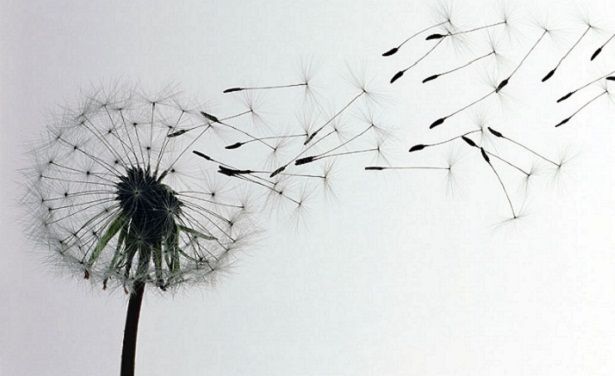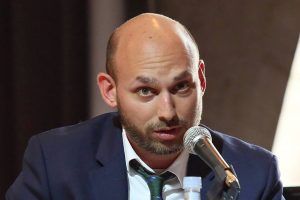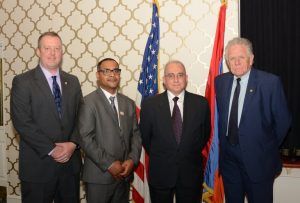Nazareth Binatli: “I wish Armenians never lose the God-given talent of creating and use it very cleverly”

We can see the unique style of Armenian architects and engineers in many countries around the world. The remarkable structures of several ancient cities were created by Armenians, who gave life to lifeless stone and left the trace of the genius minds and hands of Armenians in the epoch-making history.
Today and always, Armenians continue to build, and the traditions of ancient Armenian architecture lie at the core of their constructions.
Recently, I had an opportunity to meet a Turkish-Armenian architect and President of the Union of Armenian Architects and Engineers of Turkey Nazareth Binatli and his friend Yervant Dink, who are in Armenia. We present my interview with Binatli for Hayern Aysor.
Karine Avagyan: Welcome to the homeland, Mr. Binatli. I know that our compatriots of the Diaspora visit Armenia with the purpose of carrying out certain pro-national initiatives, and I am certain that you are no exception.
Nazareth Binatli: Thank you! Yes, you are right. Our mission is not an end in itself at all. We are here on a business trip, but every visit also enriches us with the precious feeling of longing for Armenia.
Karine Avagyan: Please, tell us when you started collaborating with the Pan-Armenian Association of Architects and Engineers and how did you start working with the Association?
Nazareth Binatli: I am a construction engineer by profession. I have many friends who have graduated from universities and are architects, engineers, electricians, mechanics and designers. About 20 years ago, we decided to gather people with the same professions and get to know each other. In 2000, we started holding meetings and talked about establishing a union, association or institution…The result was the creation of our union with the support of my sons, who are also university graduates. I asked my younger son to work in this direction with his friends. They got excited and started searching for the rules and formats for establishing organizations. Lawyer Diran Bagrat helped us a lot with his profession. Our “HayTchar” Union was eventually registered in Turkey, but the name had to have meaning. We translated the name into Turkish and explained that the root of the word is the source or origin that revives, investigates, and people accepted it. We have been collaborating with the Pan-Armenian Association of Architects and Engineers for about seven or eight years. We started working with Director of the National Museum-Institute of Architecture of Armenia Ashot Grigoryan, who visited Istanbul a couple of times and is the Union’s best friend. Whenever the Museum hosts exhibitions, he always shows the works of most of the members of our Union.
Karine Avagyan: What is the goal of “HayTchar”?
Nazareth Binatli: Our goal was to have a place to gather, talk and make decisions. Then, the most important thing was to tour all the areas located in eastern Turkey (in the fields and mountains) and examine and register all Armenian churches, cross-stones, old fountains, bridges and examine their conditions. Our goal is to renovate and build estates belonging to the community. We have participated in the restoration and renovation of different buildings. We also established a new union in Turkey called “Union for the Preservation of Cultural Heritage” composed of nearly 200 Armenian architects and engineers (including specialists from Armenia) and started touring. The group included archaeologists, architects, engineers and historians. We toured the sector of Cilicia for a week. We prepare booklets about cultural monuments located in those areas. The booklets feature photos and drawings that are the works of the Union, including the renovation of the St. Mary’s Church of Peshiktash in Istanbul, the St. Kirakos Church in Diyarbakir, the Holy Cross Church on Akhtamar Island and the building of the Armenian school in Beshiktash and the renovation and restoration of other Armenian architectural structures. Armenian builders and architects and the skillful masters have not only built Armenian churches, cross-stones, bridges and fountains, but also the historic buildings and monuments of the West and still continue their activities. The ultimate goal of our Union is to restore Armenian architectural heritage. Our primary goal is to clean and fence those spiritual and cultural monuments so that animals don’t enter and the stones are not taken, after which we will start undertaking renovation, which requires financial investments.
Karine Avagyan: You have obviously taken photos of all the monuments you have visited and registered monuments. Aren’t you planning on opening an exhibition of those photos in Armenia? God forbid, the more damaged of those monuments might be in a worse condition in a couple of years and their traces might be eliminated, and Armenians will at least be able to see them in photos.
Nazareth Binatli: Yes, we have taken photos of them. I agree that there is a need for such an exhibition, and we will consider it. Among the monuments we have seen are monuments that are dilapidated (there is only a wall and some stones). Time, rain, snow, winds and the human factor destroy them…So, I accept your observation.
Karine Avagyan: Mr. Binatli, do the Turks accept the fact that most of the monuments, buildings and constructions of that territory were built by Armenians?
Nazareth Binatli: Yes, they do, but it is not definite because sometimes they deny it.
Karine Avagyan: As an engineer, what do you have to say about architecture in Yerevan today?
Nazareth Binatli: Yerevan used to have a unique look with its architecture, but that is not the case today. Beside the buildings built with very correct and beautiful solutions of Tamanyan we see 15- and 18-floor buildings that are in no way linked to the structures built with old and Armenian architectural sculptures. Of course, there is a need for such tall buildings, but they can be built in suburbs and the outskirts of the city. In general, Armenia is a very beautiful country, and Yerevan is also very beautiful.
Karine Avagyan: Mr. Binatli, as a professional, which stone do you think is the right stone for building a home?
Nazareth Binatli: Armenian tuff is the best stone. It is solid, light and ��?breathing’. It is also beautiful. Our tuff is one of the riches of the Armenian nation.
Karine Avagyan: Let’s talk about your future plans. How do you see the future of “HayTchar” Union of Armenian Architects and Engineers? What are the prospective goals?
Nazareth Binatli: We are now ready to generously complete the major tasks for Armenian institutions. For instance, we participated in the works for the mausoleum of the Balyans, who were famous in the Ottoman Empire. In the 18th-19th centuries, the descendants of this family were architects of the Ottoman royalty.
The Balyans built many luxurious palaces for Ottoman sultans, Armenian churches, as well as several mosques and villas for sultans. Among the remarkable works of the Balyans are the Dolmabahche Complex of Istanbul (a work of several generations of the Balyans), the Chraghan Palace (9 generations of the Balyans worked in Turkey), and most of the architects were proclaimed as palatial architects. Ashot Grigoryan wrote the book “The Treasures of the Garden for the Armenian Nation: Balyans”, which is about the hundreds of structures (palatial and military structures) built in Istanbul and designed by the Balyan family of architects.
We also plan on working on structures that are in need of our help, be it a church, a school or a building. A camp for children is also under construction based on our design. It is a camp where children can spend their vacation in the summer, and in the winter, it will become a center like TUMO Center for Creative Technologies. In fact, we have ties with the TUMO Center in Yerevan.
Karine Avagyan: Dear compatriot, you were born in the very famous and Armenian-populated Peshiktash District of Istanbul. It is your hometown, and obviously your beloved place, but what does the homeland mean to you?
Nazareth Binatli: When I say “homeland”, I get goose bumps. Words can’t describe what I feel, but the homeland fills my soul with warmth…All Armenians must see and feel the homeland at least once in their lifetime.
Karine Avagyan: What is your wish to all Armenians for the New Year and Christmas?
Nazareth Binatli: I wish Armenia becomes stronger, businesses grow and the spheres of tourism, agriculture, medicine, cattle-raising and innovative technologies develop in Armenia in 2018. I see sparks already. I wish Armenians never lose the God-given talent of creating and use it very cleverly.
Karine Avagyan: Thank you, Mr. Nazareth. I would also like to thank Yervand Dink for participating in the interview and providing additional information. I also wish you carry out more pro-Armenian activities and continue all of your initiatives in 2018.
Karine Avagyan




 Արևելահայերեն
Արևելահայերեն Արևմտահայերեն
Արևմտահայերեն Русский
Русский






